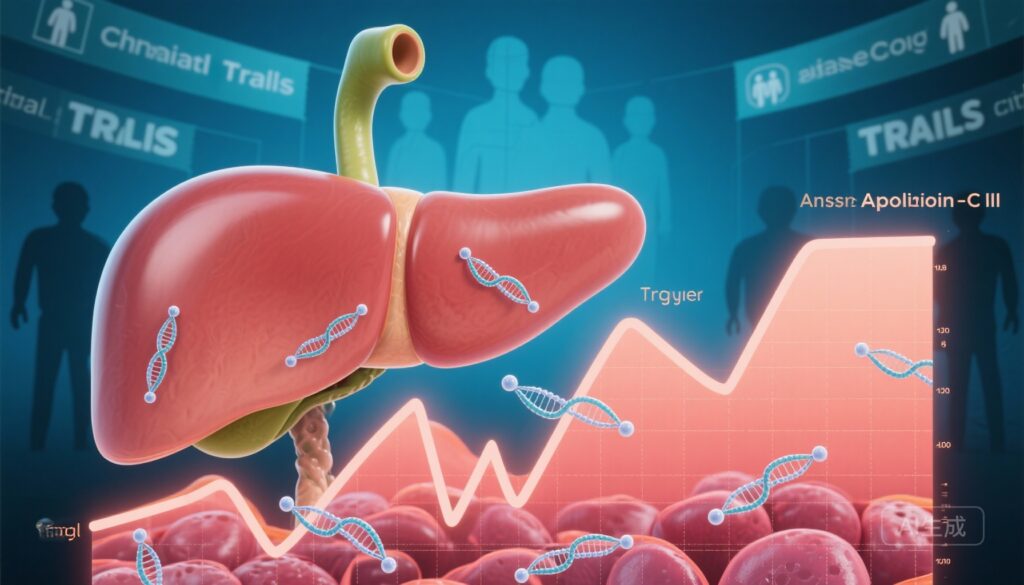Highlights
– Olezarsen, an antisense oligonucleotide targeting apolipoprotein C-III (apoC-III) mRNA, produced large, clinically meaningful reductions in triglyceride levels at 6 months versus placebo in two randomized, double-blind trials (CORE-TIMI 72a and CORE2-TIMI 72b).
– The therapy was associated with a significantly lower incidence of acute pancreatitis (mean rate ratio 0.15; 95% CI, 0.05–0.40; P<0.001).
– Safety signals included dose-dependent increases in liver-enzyme elevations, thrombocytopenia (platelet count <100,000/µL) with the 80-mg dose, and increases in hepatic fat fraction.
Background
Severe hypertriglyceridemia is an important clinical problem because very high triglyceride (TG) concentrations greatly increase the risk of acute pancreatitis and contribute to a residual atherogenic lipid burden via triglyceride-rich lipoproteins and remnant cholesterol. Therapeutic options for patients with very elevated triglycerides include lifestyle measures, dietary interventions, fibrates, high-dose omega-3 fatty acids, and management of secondary causes. Nonetheless, many patients remain at high risk for recurrent pancreatitis or have persistent marked hypertriglyceridemia despite available therapies, creating an unmet need for targeted agents.
Apolipoprotein C-III (apoC-III) is a hepatic protein that inhibits lipoprotein lipase and hepatic uptake of triglyceride-rich lipoproteins and thereby raises plasma triglyceride concentrations. Antisense oligonucleotide (ASO) therapeutics that reduce apoC-III expression have therefore been developed to lower triglycerides and potentially reduce pancreatitis risk. Olezarsen is an N-acetylgalactosamine (GalNAc)-conjugated ASO directed against apoC-III mRNA, optimized for liver delivery, allowing monthly subcutaneous dosing.
Study Design
The CORE-TIMI 72a and CORE2-TIMI 72b programs comprised two parallel, randomized, double-blind, placebo-controlled trials designed to evaluate the efficacy and safety of olezarsen in patients with severe hypertriglyceridemia. Key design elements were:
- Population: Patients with severe hypertriglyceridemia enrolled across the two trials (617 in CORE-TIMI 72a; 444 in CORE2-TIMI 72b) for a combined primary-analysis population of 1,061.
- Interventions and randomization: 1:1:1 allocation to monthly subcutaneous olezarsen 50 mg, olezarsen 80 mg, or placebo for 12 months.
- Primary endpoint: Percent change from baseline in triglyceride level at 6 months; reported as placebo-adjusted (difference between each olezarsen dose group and placebo).
- Secondary lipid endpoints: Percent change at 12 months in triglycerides and percent changes at 6 and 12 months in apoC-III, remnant cholesterol, and non–high-density lipoprotein (non-HDL) cholesterol.
- Clinical safety outcome of particular interest: Incidence of acute pancreatitis assessed across both trials.
Trials were funded by Ionis Pharmaceuticals (developer of olezarsen). Full trial registration numbers: NCT05079919 and NCT05552326.
Key Findings
Primary efficacy — triglycerides at 6 months:
In CORE-TIMI 72a (n=617), the placebo-adjusted least-squares mean percent change from baseline in triglyceride level at 6 months was:
- -62.9 percentage points with olezarsen 50 mg (versus placebo).
- -72.2 percentage points with olezarsen 80 mg (versus placebo).
In CORE2-TIMI 72b (n=444), the placebo-adjusted least-squares mean percent change at 6 months was:
- -49.2 percentage points with olezarsen 50 mg (versus placebo).
- -54.5 percentage points with olezarsen 80 mg (versus placebo).
All comparisons of olezarsen with placebo achieved P<0.001.
Secondary lipid outcomes:
- Olezarsen produced greater decreases than placebo in apoC-III, remnant cholesterol, and non-HDL cholesterol at both 6 and 12 months (P<0.001 for all comparisons).
- The reductions were dose-dependent and sustained through 12 months.
Acute pancreatitis:
Pooling events across both trials, the incidence of acute pancreatitis was significantly lower with olezarsen than with placebo: mean rate ratio 0.15 (95% confidence interval, 0.05 to 0.40; P<0.001). This represents a strong relative reduction in pancreatitis events during the trial period, and is a clinically meaningful finding given the morbidity and mortality associated with pancreatitis.
Safety and Tolerability
Overall adverse-event rates were similar across trial groups. Nevertheless, several safety signals warrant attention:
- Hepatic enzymes: Elevations in transaminases were more common with the 80-mg olezarsen dose.
- Thrombocytopenia: Platelet counts <100,000/µL occurred more frequently with the 80-mg dose.
- Hepatic fat: A dose-dependent increase in hepatic fat fraction was observed.
These findings indicate the need for laboratory monitoring during therapy (including liver-function tests and platelet counts) and raise questions about long-term hepatic safety, particularly in patients with underlying fatty liver disease.
Mechanistic Insights
ApoC-III plays a central role in triglyceride metabolism by inhibiting lipoprotein lipase-mediated lipolysis of triglyceride-rich lipoproteins and by impairing hepatic uptake of these particles. Reducing apoC-III expression with an ASO such as olezarsen accelerates clearance of triglyceride-rich particles, lowers circulating triglycerides, and reduces remnant cholesterol. The observed reductions in remnant cholesterol and non-HDL cholesterol are mechanistically consistent with decreased plasma triglyceride-rich lipoprotein burden and support the biological plausibility of reduced pancreatitis risk through lowering of the offending lipids.
Expert Commentary and Interpretation
The CORE-TIMI 72a and CORE2-TIMI 72b results are important for several reasons. First, they demonstrate that targeted apoC-III reduction via a GalNAc-conjugated antisense agent produces large, clinically meaningful triglyceride reductions in patients with severe hypertriglyceridemia—effects that are substantially larger than typically seen with conventional therapies. Second, the observed large relative reduction in acute pancreatitis events addresses a key clinical outcome and provides direct evidence that substantial triglyceride lowering in this population can translate into fewer pancreatitis events over a 12-month period.
However, interpretation requires caution. The trials report relative reductions and rate ratios for pancreatitis but do not in the published summary provide detailed absolute event numbers or long-term follow-up; clinicians will want to see absolute risk reductions, number needed to treat, and data on recurrent pancreatitis specifically. Safety signals—particularly transaminase elevations, thrombocytopenia, and increased hepatic fat—must be weighed against efficacy on an individual-patient basis and may influence dose selection and monitoring strategies. The larger reductions seen with 80 mg were accompanied by more safety signals, suggesting 50 mg may offer a more favorable balance for many patients.
Clinical Implications
Where might olezarsen fit into clinical practice if approved?
- Patients with severe hypertriglyceridemia at imminent risk for pancreatitis or with recurrent pancreatitis despite guideline-based therapy could be prioritized for consideration of an apoC-III–targeted therapy.
- Use should be accompanied by baseline and periodic monitoring of liver enzymes and platelet counts, and consideration of hepatic imaging or noninvasive assessment if increases in hepatic fat are a concern.
- Decisions about dose (50 mg vs. 80 mg monthly) will need to balance triglyceride-lowering efficacy against the dose-dependent safety signals; until more long-term data are available, the lower effective dose may be preferred for safety.
- Cost, access, and payer coverage will influence uptake; comparative effectiveness against maximal conventional therapy (fibrates, high-dose omega-3 fatty acids) and real-world safety data will be important.
Limitations and Unanswered Questions
Several issues remain to be resolved:
- Long-term safety beyond 12 months, including hepatic outcomes and the clinical significance of increased hepatic fat fraction, is unknown.
- Cardiovascular outcomes were not reported; whether apoC-III lowering reduces atherosclerotic events remains to be established.
- Absolute pancreatitis event counts and subgroup analyses (for example, by baseline TG level, presence of metabolic-associated fatty liver disease, or concomitant lipid therapies) are needed to refine patient selection.
- Generalizability to broader or more diverse populations and to patients with genetic forms of hypertriglyceridemia requires further study.
Conclusion
The CORE-TIMI 72a and CORE2-TIMI 72b trials provide compelling phase 3–style evidence that olezarsen markedly lowers triglycerides and reduces the incidence of acute pancreatitis in patients with severe hypertriglyceridemia. These effects are biologically plausible and clinically meaningful. Safety signals—particularly at the 80-mg dose—highlight the need for careful patient selection and monitoring. Pending regulatory review, longer-term safety and cardiovascular outcome data, and cost-effectiveness analyses, olezarsen has the potential to become an important therapeutic option for patients at high risk of triglyceride-mediated pancreatitis.
Funding and ClinicalTrials.gov
Funding: Ionis Pharmaceuticals.
ClinicalTrials.gov identifiers: NCT05079919 and NCT05552326.
References
Marston NA, Bergmark BA, Alexander VJ, Prohaska TA, Kang YM, Moura FA, Zimerman A, Waldman E, Weinland J, Murphy SA, Goodrich EL, Zhang S, Xia S, Li D, Goldberg AC, Goudev A, Badimon L, Kiss RG, Vrablik M, Gaudet D, Moulin P, Stroes ESG, Banach M, Cohen H, Blom D, Charng MJ, Nordestgaard BG, Nicholls SJ, Tsimikas S, Giugliano RP, Sabatine MS; CORE-TIMI 72a and CORE2-TIMI 72b Investigators. Olezarsen for Managing Severe Hypertriglyceridemia and Pancreatitis Risk. N Engl J Med. 2025 Nov 8. doi: 10.1056/NEJMoa2512761. Epub ahead of print. PMID: 41211918.



